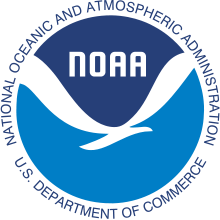State of the Climate
 |
The State of the Climate is an annual report that is primarily led by the National Oceanic and Atmospheric Administration National Climatic Data Center (NOAA/NCDC), located in Asheville, North Carolina, but whose leadership and authorship spans roughly 100 institutions in about 50 countries.
Release
The report appears as a supplement to the June issue of the Bulletin of the American Meteorological Society (BAMS), a publication of the American Meteorological Society. The State of the Climate report, known until 2001 as the Climate Assessment, is an international effort.
State of the Climate in 2010
The 2010 edition (released June 28, 2011) contained submissions from 368 authors from 45 nations and covered 41 climate indicators.[1] The 2010 edition contained a highlights document that summarized the major findings of the report.[2] The State of the Climate summarizes the global and regional climate of the preceding calendar year and places it into a historical context. In addition, notable climatic anomalies and events are discussed.
Major findings in the 2010 report were:
- 2010 was one of the two warmest years of the instrumental temperature record
- The El Niño-Southern Oscillation transitioned from El Niño to La Niña
- Changes in the Arctic and Greenland continued to outpace those across the rest of the planet, on average
State of the Climate in 2013
The 2013 edition has been released on July 17, 2014.[3] The American Meteorological Society published a supplemental paper online.[4] The report was compiled by 425 scientists from 57 countries.[5]
Major findings in the 2013 report include:
- The climate is changing faster than at any other point in recorded history.[3]
State of the Climate in 2014
A report was released for the year of 2014.[6]
State of the Climate in 2015
A report was released in August 2016 for 2015.[7][8]
2015 was the hottest year to date. Greenhouse gases were highest on record. Global upper ocean heat content was highest on record. Global sea level was highest on record.[9][10][11][12][13]
State of the Climate in 2016
August 2016 marked 16 consecutive months of record-breaking heat for the globe.[14]
See also
References
- ↑ State of the Climate in 2010
- ↑ BAMS State of the Climate - 2010
- 1 2 Sid Perkins. "Report: Climate changing more rapidly than at any point on record". AAAS.
- ↑ Bulletin of the American Meteorological Society. "State of the Climate in 2013". American Meteorological Society.
- ↑ Laura Barron-Lopez. "NOAA: Climate change is getting worse". The Hill.
- ↑ Arndt, Deke (July 15, 2015). "2014 State of the Climate: Author Q&A". climate.gov. Climate.gov. Retrieved August 12, 2016.
- ↑ Lindsey, Rebecca (August 2, 2016). "2015 State of the Climate: Highlights". climate.gov. Climate.gov. Retrieved August 12, 2016.
Global carbon dioxide levels hit a new high in 2015, and the observatory at Mauna Loa recorded the largest one-year jump in annual average concentrations.
- ↑ Milman, Oliver (August 2, 2016). "Environmental records shattered as climate change 'plays out before us'; Temperatures, sea levels and carbon dioxide all hit milestones amid extreme weather in 2015, major international 'state of the climate' report finds". theguardian.com. The Guardian. Retrieved August 12, 2016.
- ↑ Berwyn, Bob (August 2, 2016). "Latest Climate Report: Heat, More Heat and Signs of Worse to Come; 2015 featured record warm temperatures on every inhabited continent as ice melted and the seas rose at alarming rates.". InsideClimate News. Retrieved August 12, 2016.
- ↑ Samenow, Jason (August 2, 2016). "The 10 most startling facts about climate in 2015 — the warmest year on record". Washington Post. Retrieved August 12, 2016.
- ↑ Ranosa, Ted (August 4, 2016). "Climate Scientists Say 2015 Set Record Highs For Global Heat, Sea Level". techtimes.com. Retrieved August 12, 2016.
- ↑ Braun, David Maxwell (August 3, 2016). "Earth's 'Annual Physical' Lists Symptoms of a Hotter World". nationalgeographic.com. National Geographic. Retrieved August 12, 2016.
- ↑ Graham, Lloyd (August 3, 2016). "2015 was warmest on record, set a new high in sea levels, says NOAA report". The Australian. Retrieved August 12, 2016.
- ↑ "Global Analysis - August 2016". ncdc.noaa.gov/sotc. National Climatic Data Center. Retrieved September 27, 2016.
External links
- State of the Climate summaries
- BAMS State of the Climate NCDC archive of formal reports
- NOAA NCDC Climate Monitoring pages